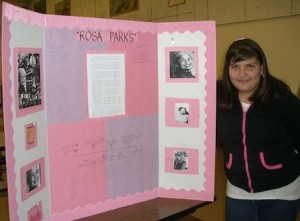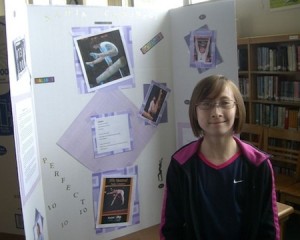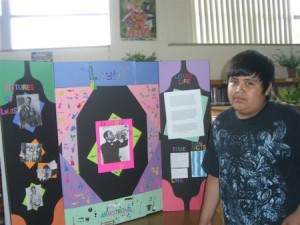Global Biography Projects: Going Deeper with Reading, Writing, Speaking and Listening
By Mallory Marquet
This past school year I was assigned to teach a new class titled English Essentials, which included students who were deemed by the school district to be “struggling” students in reading and writing. On the one hand, this was very exciting to me; I had just finished graduate work on a reading endorsement and was eager to connect this knowledge to my classroom. Yet I also faced challenges as I embarked upon teaching this class. I particularly felt troubled that these students knew they were not in a ‘regular’ Language Arts class, and so I prioritized creating a safe classroom environment that focused on improving reading skills while aiming to develop meaningful connections to what we were reading.
As the year progressed we immersed ourselves in a variety of texts and worked on a range of reading strategies. One of our top five reading strategies had been “to relate” as in; “How can you “relate” your life and experiences (or not!) to what you are reading?” “How can you put yourself in someone else’s shoes?” I put an emphasis on “relating” because I believe if children can place themselves in the texts they read, they are more likely to comprehend more fully, in turn enhancing their reading experiences. This strategy became more significant when I began the Worlds of Words Global Literacy Communities grant project and started incorporating global titles into my classroom, because by “relating” students were encouraged to engage with people and cultures that may have previously been inaccessible.
While proficient readers ‘relate’ with greater automaticity, they frequently need support in building background knowledge when reading nonfiction. The students in the English Essentials (E.E.) class needed even greater support. This became more apparent when, towards the end of the school year, the students in the E.E. classes joined fellow sixth graders in a six-week, grade-wide biography project. The project, originally designed by a fellow teacher for her master’s program, was aligned to state reading, writing, and speech standards and involved students conducting research, writing a one page paper, presenting a speech, and creating a display board. Additionally, students participated in a grade-wide “Gallery Walk” where all sixth graders would stand alongside posters they created and converse with students, parents and community members in the cafeteria.
Finding “Just Right” Books
Selecting a biography was the first stumbling block many of my students encountered when beginning the biography project. Our school library’s biography section did not have a single biography published after the year 2001 and many of the texts were in disrepair. In addition, there were very few books written at a level accessible to students in my classes. A team of teachers, myself included, were awarded funds through a district foundation grant to supplement our aging collection of biographies with newer editions. However, I still felt the need for texts that supported emerging readers and English Language Learners and included more illustrations, background content and explanations of difficult concepts.
The World of Words grant provided an opportunity for me to collaborate with other middle and high school teachers and professors to read, gather and purchase global and multicultural biographies to supplement the resources in my school library. Our small grant group explored issues such as what ‘cross cultural’ meant, what is a curriculum that is international, and how to evaluate texts for cultural authenticity. This group also helped me desconstruct pedagogy ideas about what questions I could ask my students to elicit deeper thinking, and how students can build connections and relate to a person that might be far removed from their immediate, lived experiences. We discussed the idea that ‘multi-cultural’ might encompass biographical characters that were not only from diverse cultures, but also different eras, or a culture within a culture, or from a ‘poles apart’ country, or even part of a group such as ‘the deaf community.’
This collection of new books was a boon for my students. While all sixth grade students went with their classes to peruse and choose a book in the library my students got to preview the WOW books and make selections from that collection before going to the library where the other biographies were on display.
The “Global” Biography Project
To begin our inquiries, my students brainstormed their interests and who they might want to study for their project. I read aloud excerpts and projected images from a graphic biography on Satchel Paige, the great early 20th century African American pitcher. The graphic biography told how Paige struggled with not only getting to play in the Negro Leagues during his prime, but his attempts to play in the mainstream all-white major baseball league system. We conducted a biography genre study and talked about issues such as the differences and advantages a primary account might have and showed students books by Anne Frank and books about her in the form of an authorized graphic biography, Anne Frank:The Anne Frank House Authorized Graphic Biography (Jacobson & Colon, 2010).
Other first-hand and primary accounts we looked at included Zlata Filipovi’s diary, Zlata’s Diary (1994) and the inspirational speaker Mawi Asgedom’s autobiography, Of Beetles and Angels (2002). Students particularly found his story of surviving refugee camps in Ethiopia and later attending Harvard University riveting. We also compared the saga of Claudette Colvin, a 15 year-old girl who stood up for civil rights months before Rosa Parks made her famous stand while reading Claudette Colvin: Twice Towards Justice (Hoose, 2009).
I’m not sure if students really understood these differences in primary vs. second-hand accounts or the distinction between the “less well-known but no less noble” people in the world. In fact, many students still reached for books with familiar people like Martin Luther King Jr., Bob Marley, Cesar Chavez, and Helen Keller. I was especially disappointed that the story of Jim Thorpe’s years at Pennsylvania’s Carlisle Indian School (Jim Thorpe: Original All American, Bruchac, 2006) and the lyrical biography of Cuban slave Juan Francisco Manzano (The Poet Slave of Cuba, Engle & Qualls, 2006) were not snapped up as project subjects. Sadly, neither was the story of Mami “Peanut” Jackson who, inspired by Jackie Robinson, longed to be the first black, female professional baseball pitcher. This raised questions for me about how to invite students to read these important stories without diminishing their opportunities for choice over the texts they read.
Reading and Presenting the Biography Studies
As I noted earlier, I saw the participation in this grade-wide project as facilitating a more authentic application of strategies we had been working on throughout the year, particularly “relating.” I asked students to ‘relate’ to these individuals they were researching as we had practiced when reading together in class and independently. To facilitate this I invited students to share with a reading buddy why they had selected that particular person for the project. Then the partner would recall and explain their partner’s choice. My thinking was that children might dig a bit deeper as they described and justified their choices to a trusted peer. I also thought students might be able to hear their own thinking more clearly as it was reflected back to them. Students had two days in which to change their biographical subject based on interest or the reading level of the book.
After selecting their biographical books, each student began reading daily during class. To keep their interest I often had a mini-assignment before reading, such as looking for the most interesting, confusing, scariest, or funniest excerpt from that day’s portion. I frequently asked students to tell how they ‘related’ to a particular section or how their subject’s life was so different they had difficulty in ‘getting’ what was going on. I experimented with different lengths of time for independent reading. Sometimes I had students write a ‘quick book report,’ no more than two sentences, instead of always taking notes. We regularly had whole group discussions involving how their lives were similar to those of the person in the books, or what was difficult for them to believe and why?
I found that students would often ‘put themselves in someone else’s shoes,’ but I struggled to draw out more complex responses. For example, while discussing Jackie Robinson, one student said if he was there he would ‘just punch them’ when a spectator stands up and spits on a player because of their skin color. I could see students ‘getting’ the concept of injustice, but struggling to fully understand how limited choices really are for people living in a particular time and place. To expand their perspectives I asked students to visualize the injustices they felt and experienced at the hands of other children and adults then extend those feelings to knowing that those injustices would be a permanent way of life with no hope of change. My goal was to spark empathy without promoting fear or engaging in lengthy role-playing scenarios.
My ongoing thinking was to segment and scaffold each step of the project so excitement could be maintained, preventing discouragement with the often overwhelming project. Students often lost their zeal as the challenging work of writing an essay, creating a display board, mapping out a speech then finally presenting in front of classmates played out. Some of that enthusiasm returned when they participated in a gallery walk that indicated the successful end of their hard work. Students basked in the recognition from the community at large and from students throughout the school.
Conclusions
This experience has left me reflecting on my teaching, particularly on working with “struggling” readers. I intend to explore how to provide different expectations around text choice and frontload more ‘alternative’ biographical subjects. I’m also reflecting on the importance of literacy being in service to content, and the role of global inquiry in preparing students for 21st Century demands. My goal for next year is to hopefully support students in forming deeper questions and understandings as to why we delve into biographies of the famous and “not-so-famous.” I will continue to draw on my social studies background to scaffold students in exploring complex issues of culture and diversity. The biography project in conjunction with WOW’s Global Literacy Communities affirmed for me that children have great capacity for empathy and compassion. I am eager for the coming school year to again address each child’s needs, nurture these qualities of caring for others, and develop our understandings of global concepts in an educational context.
Children’s Literature Cited
Asgedom, M., & Berger, D. (2002). Of beetles & angels: A boy’s remarkable journey from a refugee camp to Harvard. Boston: Little, Brown, and Co.
Bruchac, J. (2006). Jim Thorpe: original all-American. New York, NY: Dial Books/Walden Media.
Engle, M., & Qualls, S. (2006). The poet slave of Cuba: A biography of Juan Francisco Manzano. New York: Henry Holt.
Filipović, Z. (1994). Zlata’s diary: A child’s life in Sarajevo. New York: Viking.
Hoose, P. M. (2009). Claudette Colvin: Twice toward justice. New York: Melanie Kroupa Books/Farrar Straus Giroux.
Jacobson, S. & Colon, E. (2010). Anne Frank: The Anne Frank House authorized graphic biography. New York: Hill and Wang.
Mallory Marquet is a secondary educator teaching sixth graders at Memorial Middle School in Reading, Writing, Health and Food Gardening. She is a coach for Oregon Battle of the Books, and this school year she spearheaded the school’s first Family Geography Night.
WOW Stories, Volume IV, Issue 2 by Worlds of Words is licensed under a Creative Commons Attribution-NonCommercial-ShareAlike 4.0 International License.
Based on a work at https://wowlit.org/on-line-publications/stories/storiesiv2/.



